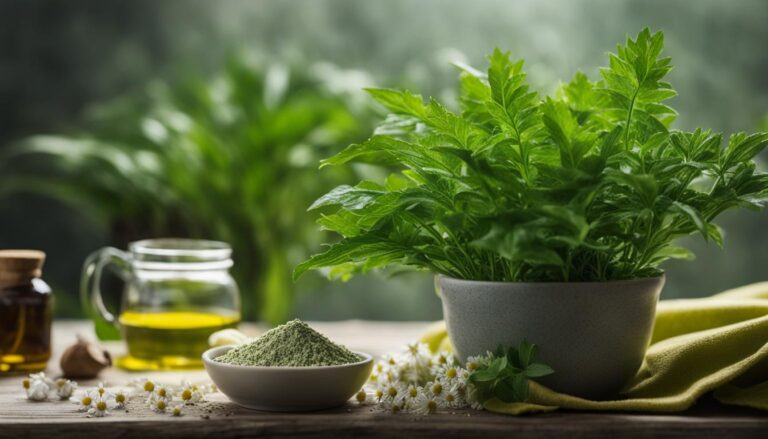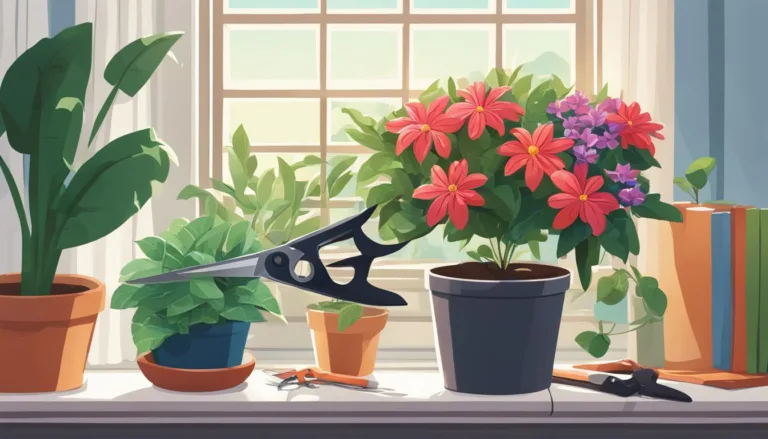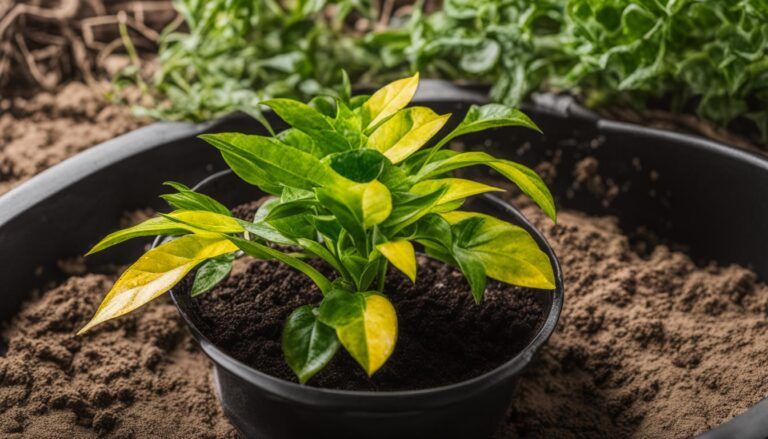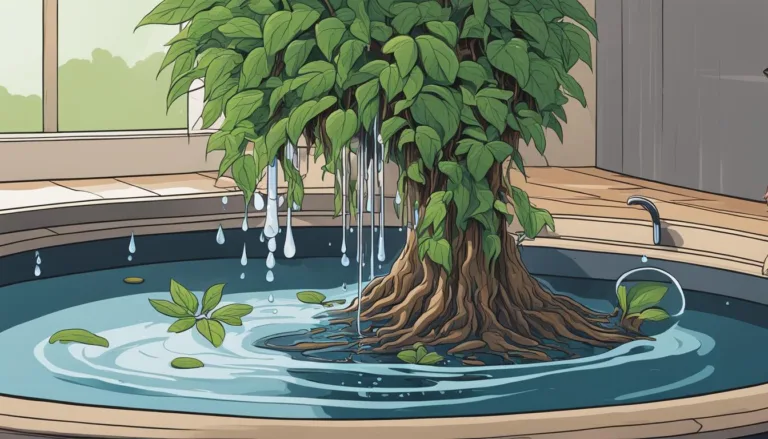
Healthy indoor plants are more resistant to pests and diseases. To keep your houseplants strong, make sure to meet their specific cultural requirements, including using proper soil, avoiding drafts, not overcrowding plants, and maintaining a good balance of temperature, humidity, light, water, and drainage.
If you’re unsure about your plant’s requirements, check a reliable plant care resource for guidance. But, if your plants are already affected by diseases, there are solutions available to treat and control them.
Key Takeaways:
- Meeting the cultural requirements of indoor plants helps keep them healthy and resistant to diseases.
- Proper soil, temperature, humidity, light, water, and drainage are important factors for plant health.
- Consulting reliable plant care resources can provide guidance on plant requirements.
- There are treatments available to control and treat common indoor plant diseases.
- Taking preventive measures can help avoid the spread of diseases among indoor plants.
Common Diseases and Their Identification
Indoor plants are susceptible to a variety of common diseases that can hinder their growth and overall health. Recognizing these diseases early is crucial for effective treatment and prevention. Here, I will discuss some of the most prevalent plant diseases and how to identify them.
Disease: Crown and Stem Rot
Crown and stem rot is caused by fungal mycelia and can lead to black or discolored rotten patches at the base of the plant. As the disease progresses, the affected plant parts may become soft and mushy. To identify crown and stem rot, carefully inspect the base of your plant for any signs of discoloration or decay.
Disease: Powdery Mildew
Powdery mildew appears as a white powdery film on the leaves, stems, and flowers of the plant. This fungal disease thrives in warm and humid conditions. Infected plant parts may also become distorted or stunted in growth. To confirm the presence of powdery mildew, gently touch the leaves and check if a powdery substance rubs off onto your fingers.
Disease: Rust
Rust is a fungal disease that typically manifests as reddish-brown or orange-colored spots on the leaves, stems, or fruit of the plant. The affected areas may also develop powdery spores. Rust is most common in areas with high humidity and poor air circulation. Inspect your plant for any signs of discoloration or unusual spots to determine if it has rust.
These are just a few examples of common plant diseases and their identifying symptoms. By familiarizing yourself with these diseases, you can take prompt action to treat and prevent their spread. In the next section, I will discuss effective methods for treating and preventing indoor plant diseases.
Treating and preventing indoor plant diseases
When it comes to maintaining the health of indoor plants, it’s crucial to understand how to treat and prevent common plant diseases. By following a few simple tips, you can keep your plants thriving and free from harmful diseases.
Proper plant care
The first step in disease prevention is providing your plants with the proper care they need. Ensure that your plants are placed in suitable environments with the right balance of temperature, humidity, light, water, and drainage.
Different plants have different requirements, so it’s important to research and understand their specific needs. By meeting these cultural requirements, you can promote strong and healthy plants that are more resistant to diseases.
Identifying and addressing diseases
To effectively treat plant diseases, it’s essential to be able to identify them. Familiarize yourself with common diseases and their symptoms, such as crown and stem rot, powdery mildew, and rust. Once you’ve identified a disease, take immediate action to address it.
This may involve removing infected parts of the plant, using appropriate fungicides, or improving ventilation to prevent the spread of fungal diseases. Prompt and targeted actions can help control the diseases and minimize their impact on your plants.
Regular inspections and maintenance
Prevention is key when it comes to indoor plant diseases. Regularly inspect your plants for any signs of diseases, such as discoloration, spots, or abnormal growth.
By catching diseases early, you can take swift action to prevent their spread and save your plants. Also, practicing good hygiene, such as cleaning gardening tools and avoiding cross-contamination between plants, can help prevent diseases from entering your indoor garden.
By following these indoor plant health tips and taking proactive measures, you can effectively treat and prevent common plant diseases. Remember to provide proper care, identify and address diseases promptly, and maintain regular inspections and maintenance. With these strategies in place, you can enjoy a thriving indoor garden that is free from harmful diseases.
Common pests and their management
Indoor plants can sometimes face the unwelcome presence of pests. These pests, such as aphids, fungus gnats, spider mites, whiteflies, and thrips, can cause various damages to the plants if not addressed promptly. Understanding how to identify and handle these pests is essential for maintaining the health and vitality of your indoor plants.
Aphids are small insects that feed on the sap of plants, causing stunted growth and wilting. To control aphids, you can spray the affected plant with water to physically remove them or use an indoor insecticide spray specifically designed for aphid control.
Fungus gnats are tiny flying insects that thrive in damp soil. They can damage the roots of your plants and hinder their growth. To manage fungus gnats, you can spray the plant with a mixture of water and mild liquid soap or set up yellow sticky traps to catch the adult gnats.
Spider mites are minuscule pests that feed on plant sap, causing yellowing leaves and webbing. To eliminate spider mites, you can wipe the leaves with a cloth soaked in a solution of dish soap and water or use rubbing alcohol, which helps control their population.
| Pest | Control Method |
|---|---|
| Aphids | Spray with water or use indoor insecticide spray |
| Fungus gnats | Use a mixture of water and mild liquid soap or set up yellow sticky traps |
| Spider mites | Wipe leaves with a cloth soaked in dish soap and water or use rubbing alcohol |
| Whiteflies | Treat with neem oil, insecticidal soap, or petroleum-based oils |
| Thrips | Prune and treat with mild treatments like insecticidal soap or neem oil |
Whiteflies are small insects that typically reside on the underside of leaves and cause leaf yellowing and wilting. To combat whiteflies, you can use neem oil, insecticidal soap, or petroleum-based oils as they are effective in controlling and reducing their population.
Thrips are slender insects that feed on plant tissues, causing distorted leaves and flower buds. To manage thrips, you can prune and remove the affected plant parts and treat the remaining plant with mild treatments like insecticidal soap or neem oil to prevent further infestation.
By recognizing the signs and implementing appropriate control methods, you can effectively manage common pests in your indoor plants. Regular monitoring and early intervention will help ensure the health and beauty of your cherished green companions.
Abiotic Issues and Their Solutions
When it comes to indoor plants, it’s not just diseases and pests that can cause issues. Environmental and physiological conditions can also have a significant impact on the health and vitality of your houseplants.
These abiotic issues can lead to sunburned leaves, overwatering, underwatering, stretching, and weak growth. But don’t worry, there are solutions to these common problems.
One common abiotic issue is sunburned leaves, which can occur when your plants are exposed to direct sunlight for extended periods.
To prevent this, simply move your plant away from the intense sunlight or provide some shade. This will help protect the leaves from getting scorched and maintain their overall health.
Overwatering and underwatering are two issues that many plant owners face. Both can have detrimental effects on your indoor plants. To avoid overwatering, make sure to allow the soil to dry out between waterings.
Conversely, if you notice signs of underwatering such as wilted leaves or dry soil, give your plants a good soak. Finding the right balance and following proper watering practices will go a long way in ensuring the health of your plants.
Another abiotic issue is stretching, which occurs when plants don’t receive enough sunlight. This can lead to weak, elongated stems and sparse foliage. To prevent stretching, provide your plants with adequate sunlight or use plant lights if natural light is limited. This will help promote compact growth and keep your plants looking their best.
Lastly, weak growth can be a result of various factors such as insufficient light or improper watering. To address this issue, ensure that your plants are receiving the right amount of light for their specific needs.
Also, make sure to water them appropriately based on their individual requirements. By providing optimal conditions, you can encourage strong and healthy growth.
FAQ
How can I combat common indoor plant diseases?
To combat common indoor plant diseases, it is important to meet the specific cultural requirements of your plants, such as using proper soil, avoiding drafts, not overcrowding plants, and maintaining a good balance of temperature, humidity, light, water, and drainage. If your plants are already affected by diseases, there are solutions available to treat and control them.
What are some common indoor plant diseases and how can I identify them?
Some common indoor plant diseases include crown and stem rot, grey mold, white mold, nutrient deficiency, powdery mildew, rust, sooty mold, and viruses. Each disease has unique symptoms that can help identify them. Crown and stem rot appears as black or discolored rotten patches at the base of the plant, while powdery mildew appears as a white film on the leaves.
How can I treat and prevent indoor plant diseases?
To treat and prevent indoor plant diseases, there are several steps you can take. For crown and stem rot, cut out the infected parts of the plant and dust with an anti-fungicide. To prevent white mold, gently rake the affected soil and improve ventilation. Nutrient deficiency can be treated by fertilizing or repotting the plant. Powdery mildew can be controlled by removing infected leaves and using a fungicide spray. Rust can be managed by removing infected leaves and using a product containing specific ingredients. Sooty mold can be removed by wiping the leaves with a damp cloth and addressing the underlying pest problem. Unfortunately, there is no cure for most plant viruses, but proper care can help the plant coexist with them for many years.
What are some common indoor plant pests and how can I manage them?
Common indoor plant pests include aphids, fungus gnats, spider mites, whiteflies, and thrips. Aphids can be removed by spraying the plant with water or using an indoor insecticide spray. Fungus gnats can be controlled by spraying the plant with soap and water or using yellow sticky traps. Spider mites can be eliminated by using dish soap or rubbing alcohol. Whiteflies can be treated with neem oil, insecticidal soap, or petroleum-based oils. Thrips can be pruned and treated with mild treatments like insecticidal soap or neem oil. It’s important to properly identify the pests and use appropriate control methods for each.
What are some common abiotic issues with indoor plants and how can I solve them?
Common abiotic issues with indoor plants can be caused by environmental or physiological conditions. Some of these issues include sunburned leaves, overwatering, underwatering, stretching, and weak growth. Sunburned leaves can be avoided by moving the plant away from direct sunlight. Overwatering and underwatering can be managed by following proper watering practices. Stretching can be prevented by providing adequate sunlight or using plant lights. Weak growth can be improved by ensuring the plant gets sufficient light and watering appropriately. It’s important to monitor your plants and address abiotic issues promptly to maintain their health and vitality.







One Comment
Comments are closed.